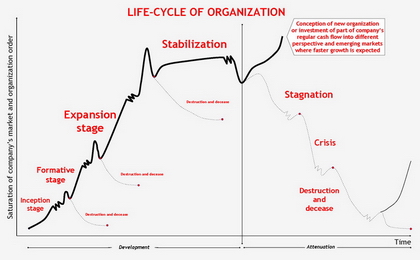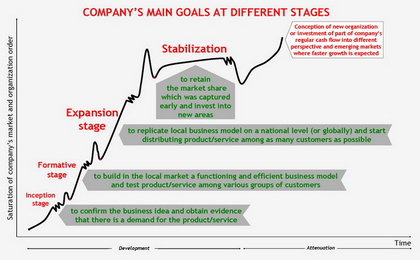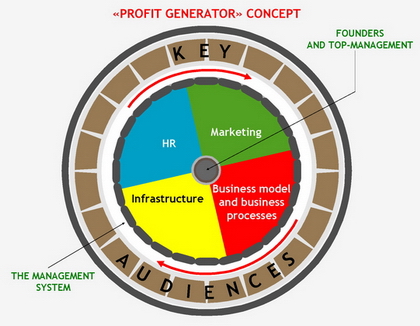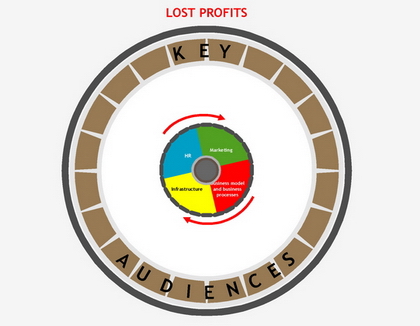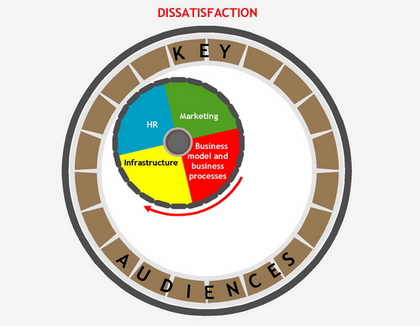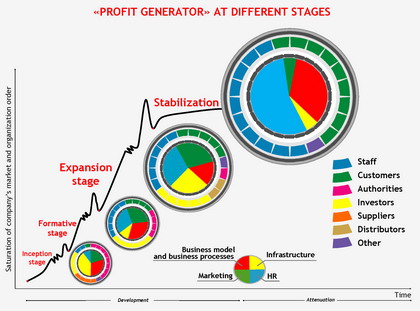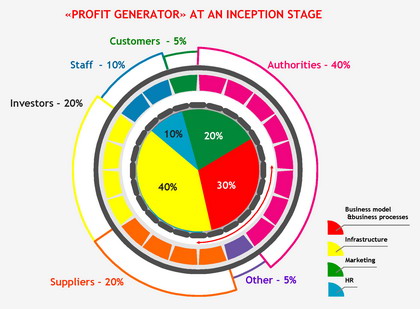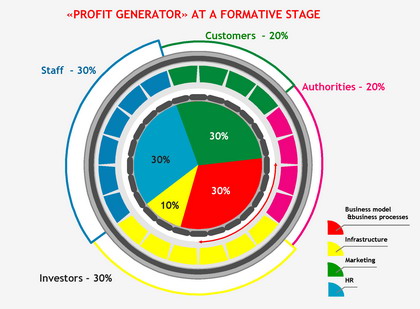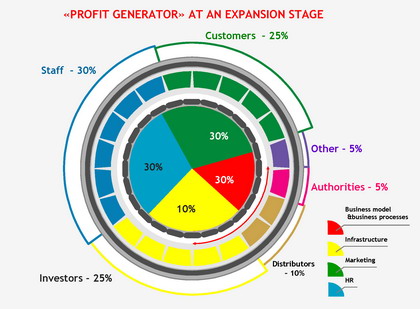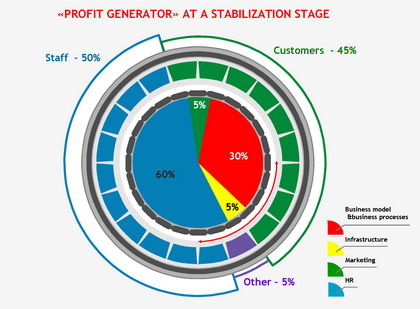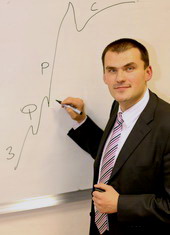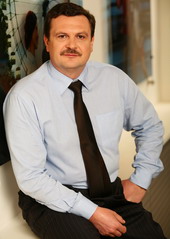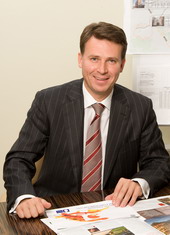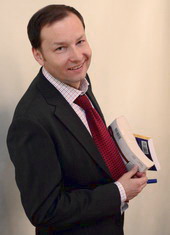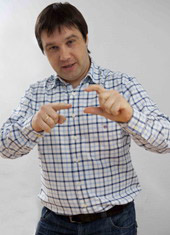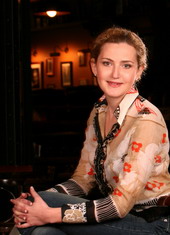SUMMARY
“PROFIT GENERATOR or How to build effective retail service company in Russia” e-book came out in spring of 2010 (updates of the book were in March 2011 and March 2012).
The idea of the book was born in autumn 2008 when the world economic crisis was in full swing. In Russia, manufacturing sectors were in decline, millions of people lost their jobs, whereas retail service companies showed growth or, at least, demonstrated stable dynamics. What kind of economic sector is it and why could it resist the world economic downturn? That’s why we decided to write a book about phenomenal growth of the Russian retail service sector and to look at histories of the most successful companies.
In this book we tried to find and explain characteristics, features and reasons of expansion of the service sector in Russia over the last decade. And our research was based on four fundamental points.
Firstly, over the last hundred years the world economy has gone through a revolution in the service industry. Greater significance of human factor and automation demands of companies to change management approaches since traditional management theories based on manufacturing experience which dominated in the 20th century are least appropriate for service companies.
Secondly, any service company as well as any company in the world passes through defined stages of growth, progress and regression during its life-cycle. Theory of organization’s life-cycle enables managers to understand what kind of a managerial approach is essential at different stages of a company’s life to stay successful on the market.
Thirdly, at every stage of a company’s life-cycle, the features of management system of the company and the structure of key audiences are constantly changing, but always need to correspond to each other. This principle of correlation of two systems resembles the principle of rotation of electric generator, consisting of induction coil and magnets. If size of induction coil corresponds to the size of magnets, electric generator can produce electricity. In our case, if characteristics of management system correspond to the structure of key audiences at every stage of company’s life-cycle, such company can “generate” profit.
Fourthly, key factors affecting service quality and other attributes can differ depending on the type of retail service.
We examined these four theses conceptually and in case studies based on success stories of five Russian service companies.
Business cases of the five service companies were written by CEOs and top-managers of those companies who know them well from the inside.
The first case illustrates phenomenal history of MegaFon, second largest cellular operator in Russia. Over the last 15 years, its business has grown organically by 15,000 times to a multinational level with 50 mln subscribers. Surprisingly enough, it is possible to build a company in Russia with capitalization over $15 billion outside of oil and gas industries.
The story of Comstar-UTS, the largest Internet provider in Russia, demonstrates how to achieve a leading position in telecom segments via mergers, acquisitions, and business integration in national scale.
The story of TNK-BP, third largest fuel retailer in Russia, reveals how to build an effective retail business based on oil manufacturing and become the national standard in the retail fuel business in Russia and Ukraine.
The story of Euroset, the largest mobile phones retailer in Russia, tells how to become the fastest growing retail network in the world with a turnover over $5 bln and how to overcome risks of a collapse stemming from such a rapid development.
The fifth case covers track record of RPCOM, a holding company running national-famous restaurant networks “Goodman”, “Filimonova and Yankel”, “Kolbasoff”, and “Pasta della Mamma”. This is an excellent example of creative and effective Russian business model working not only in Russia but also Ukraine and the UK.
All the cases pivot around the main idea of “PROFIT GENERATOR” as a basis to identify their processes at every phase of company development from inception to stabilization.
SERVICE REVOLUTION
In addition to the practical cases, we analyze reasons and patterns of the rise of service companies not only in Russia but also all over the world. No doubt, the last 30-40 years have been a witness to a service revolution and weakening of industrial giants.
There are different forecasts of the future development of the United States’ economy but the fact is that in 1947 service industries contributed only 20% to the US national GDP, while in 2008 their share was approximately 80%. Other developed countries, such as the European Union, Japan, and Australia show the same patterns.
On the contrary, countries on the ‘roadside of civilization’ (Somalia, Afghanistan, Central African Republic, etc.) have small service sectors (10% — manufacturing, 25% — service, 65% — agriculture).
China, as the World’s Factory, also demonstrates fast growth of service industries (48% — manufacturing, 40% — service, 12% — agriculture). The next decade, service sector will be dominant in China’s GDP.
In Russia, despite strong reliance on mineral resources, services are already prevailing in GDP (37% — manufacturing, 58% — service, 5% — agriculture). In the future, the share of manufacturing and agriculture in Russia’s GDP will keep decreasing.
THEORY OF ORGANIZATIONAL LIFE-CYCLE
Authors of the book analyze the Russian economy, industries, and companies in the light of the theory of organizational life-cycle. This theory postulates that any system passes through the same stages during its development.
At the beginning, any business starts at a inception stage, then moves to a formative stage, after that prepares for expansion and fight for national market share. In conclusion of successful nation-wide growth, the company moves on to a stabilization stage. It can be locked in for years at this stage provided that there is a demand for its products.
Still, stability cannot last forever. Consistent market is a very competitive one characterized by a large number of efficient firms and relatively slow growth (max 2-4% per year by contrast with 20-30% at an expansion stage). At a stabilization stage, the company invests part of its regular cash flow into different perspective and emerging markets where faster growth is expected. Given that its business environment is in constant change, when the company fails follow the development, its products or services lose touch with demand, it passes to a stagnation stage and, most probably, ends up driven out of business.
The book includes an in-depth explanation of primary goals of a company at every phase of its life-cycle. These goals change from one stage to another.
The primary objective at an inception stage is to confirm the business idea and obtain evidence that there is a demand for the product/service.
The key objective at a formative stage is to build, first in the local market, a functioning and efficient business model and test product/service among various groups of customers.
The key objective at an expansion stage is to replicate local business model on a national level (or globally) and start distributing product/service among as many customers as possible. This is the time for a tough fight with other competitors for a bigger chunk of the market.
The main objective at a stabilization stage is to retain the market share which was captured early and invest into new areas.
The majority of Russian industries and companies are at an expansion stage now and will stay there, at least, until 2015-2017. Most companies in the developed counties are now at stabilization or stagnation stages. For the next 5-10 years, when national markets will get saturated, Russian companies will stabilize and become similar to companies from the developed countries and have similar problems. A possible solution to the problems related to market saturation and vicious competition can be found in international expansion which will become very popular among Russian companies in the next few next years.
“PROFIT GENERATOR” CONCEPT
Logically, if the objectives are changing on every stage of the life-cycle of organization, the same processes should affect the features of management system and its audiences of key influence. They are changing too.
At the beginning, founders and senior management of a service company create management system consisting of 4 main elements: business model (including business processes), infrastructure, HR, and marketing. The management system is created in compliance with industry regulations and with due regard for the level of automation and key groups that influence business processes in a given service industry.
Key audiences which have great influence on a service company include customers, investors, authorities, suppliers, distributors, and, of course, service staff.
Correlation between the management system and key audiences resembles the principle of rotation inside an electric generator between induction coil and magnets. If executives make a dynamically symmetrical correlation between the management system and key audiences, a company starts to generate “energy” (profit).
If there is no correlation, it drives company out of business. Here are some examples:
If the management system is excessive, cumbersome and sluggish, it impedes fast decision-making and fails to meet the audience’s demands. Eventually, the management system becomes the company’s main expense item. It drives the company to losses and, in the long run, to an end of business.
Another situation is quite usual – business and audience’s demands have grown, but the company’s management system stays unchanged and at the same level of development as it was at the beginning. In this case, audience’s demands will be met by competitors and this will also deprive the company of a certain share of profit.
If the company begins to focus only on one audience (e.g., investors, as it seeks to increase market capitalization and in doing so, forgets about customers, staff and other key audiences), it would cause dissatisfaction on the part of the neglected audiences. This can drive the company to bankruptcy, if executives fail to redress the situation immediately.
Successful companies have dynamically symmetrical correlation between the management system and key audiences!!!
It is also very important for the company to be able to generate profit over long periods of time and in different market environments. That is why executives have to adjust the management system and structure of key audiences at different stages of the company's life-cycle.
At an inception stage, the main objective of an organization is to confirm business idea and obtain evidence that there is a demand for its product/service. To answer these questions, executives need to find sources of financing and obtain all licenses (in Russia it is not as easy as in the developed counties). It is important to build service infrastructure (bank branches, mobile networks, points of sales, etc.) and start providing services to customers at the local market. That is why, at an inception stage the most significant audiences include investors and authorities but key features of the management system are business model and infrastructure.
What about customers and marketing? Russian service companies’ experience shows that these factors are not so important in an unsaturated market. Clients will wait patiently. Is it only a Russian experience? We do not think so – one might recall Apple’s release of its unique iPhone when the company paid no attention to millions of excited customers waiting in queues all night long. The same took place in Russia in 1990s when thousands of clients assaulted POSes to get any new service (cellular subscription or a table in a good restaurant, for example).
If the service is really in demand, the company’s executives might start thinking about further development. In this case, the main objective at a formative stage is to build a working and efficient business model in the local market and to test product/service on different groups of customers. The most important audiences turn out to be the company’s staff and investors looking to fund further development. Finally, it is important to create an attractive marketing “package” for the commercial proposal and explain to customers the difference between the company and its rivals.
At last, the company gets positive feedback from the local market and has confirmation of a profit level that is enough to launch national expansion. At this time executives need to watch carefully over the company’s growth to prevent overheating which could drive the company to faulty decisions, overestimation and, eventually, cause the differences in the quality of service in various regions. This is especially important, since usual annual growth rates across various Russian service industries ranged from 30% to 100%, except for the global crisis period (2008-2009).
Companies can grow for a long time, but not for ever. In any case, annual growth rate of 50-100% is not sustainable in the long run because any market has its limits. Stabilization stage comes after the stage of fantastic growth. Market becomes saturated with similar services and is firmly divided among players, and it is impossible to change the situation when customers perfectly know companies and their brands and business cannot grow by more that 2-5% per year. At this stage, the company needs to focus on service skills of the staff and customer support.
If the company does not have an opportunity to source new customers on the national market, executives might want to start thinking about investing part of the cash flow from operations into other developing markets in their home county or tapping into unsaturated markets overseas.
Senior managers of the five successful Russian service companies have contributed pieces about their companies’success stories specifically with “PROFIT GENERATOR” concept in mind.
BOOK’S TARGET AUDIENCE
FREE ACCESS TO THE BOOK
Instead of publishing the book, we decided to place it on the Internet and give free access to all 370 pages.
By doing this, we aimed to raise the number of readers. In Russia, business books usually have a print run of 2,000-5,000 hard copies and are distributed only in big cities. We decided to take a bit different route and give opportunity to people anywhere Russia to download the book for free.
2 years down the road, the book has garnered excellent reviews and has been downloaded by more than 70,000 readers!
Also, an e-book is quite convenient in terms of updating cases studies. We update information about featured companies twice a year. It could not have been possible, if we had had only a printed version.
ЕСО-FRIENDLY
World Wide Fund for Nature (WWF) estimates that by 2050 bioresources of the Earth will most probably have run out. This is especially relevant to forests.
Book printing means forest cutting, water wasting, and discharge of effluents produced by paper mills. For the production of 1 ton of paper, 17 trees need to be felled. This amount of trees could provide oxygen for 50 people. If we had printed as many copies as have been downloaded (70,000), it would have required more than 550 trees.
Millions of books collect dust sitting on the bookshelves and never get read. We want our book to find readers without causing damage to the nature.
Our e-book is easy to download from any corner of the world. We have prepared two versions of the book: one for reading from the screen, the other – for paper version suitable for printing on printers. As six months statistics shows, 95% of readers prefer to download screen-view version. Now we are sure people are ready to read books on computers and forget about hard copies.

